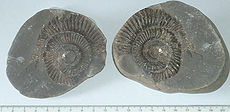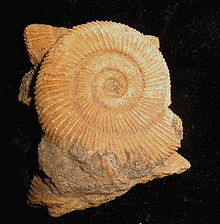- Dactylioceras
-
Dactylioceras
Temporal range: Jurassic
fossil Dactylioceras, Chesil Beach, England Scientific classification Kingdom: Animalia Phylum: Mollusca Class: Cephalopoda Subclass: †Ammonoidea Order: Ammonitida Suborder: Ammonitina Superfamily: Eoderocerataceae Family: Dactylioceratidae Genus: Dactylioceras
Hyatt, 1867Species[1] - D. alpestre
- D. athleticum
- D. commune
- D. comptum
- D. kanense
- D. pseudocommune
- D. simplex
- D. tenuicostatum
Dactylioceras was a widespread genus of ammonite from the Jurassic period, approximately 172 million years ago (mya).[1] They are generally small, averaging 65 mm in diameter.
Dactylioceras has a strong, ribbed shell. The ribs are slightly inclined forward, running over the outer edge, and either simple or forking at outer end. Though it eventually died out 180 mya, their style of ribbing was copied by numerous subsequent ammonite genera until the whole group became extinct 65 million years ago with the dinosaurs.
Dactylioceras probably lived by scavenging on the sea floor. Mass mortality specimens of Dactylioceras are common, and perhaps suggest that these ammonites may often have died shortly after spawning. The dead shells were probably gently washed up into a shell bank on the margins of the Lower Jurassic seas. Flow tank experiments show that Dactylioceras was probably a slow swimmer.
Dactylioceras has been collected from almost every continent, and was one of the most successful ammonite lineages ever. They are abundant throughout Europe, with exceptionally fine specimens found in England and Germany. Like many other ammonites, the genus Dactylioceras is extremely important in biostratigraphy, being a key index fossil for identifying their region of the Jurassic.
The name Dactylioceras comes from the Greek dactyl, meaning “finger”, and refers to the shell’s branching ribs.
References
- ^ a b Dactylioceras on the Paleobiology Database. 2010-01-01.
Categories:- Ammonites
- Jurassic ammonites
Wikimedia Foundation. 2010.


